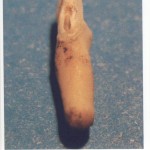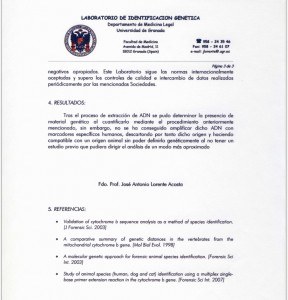Yes, it’s Chupacabras not Chupacabra.
Remember the “Chupacabras craze” of the mid 90s? Shirts, songs, cartoons and toys were helping the Chupcabras become a household word.
Originally reported in Puerto Rico, the news of this strange and scary creature spread like wildfire through the Americas. As the Spanish speaking media started to disseminate the first reports and detailed description of the creature, the reports came flooding in.
From Brazil to the United States, most of the reports came from farmers who inexplicably had found their livestock either torn apart, or had their blood completely “sucked” dry. Many theories sprang up as well. 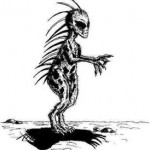 Could this be a case of mass hysteria and local predators to blame? Did it come from a UFO or were government forces to blame for a godforsaken project gone awry? Who knows. What is known is that most of the descriptions of this creature were similar. An animal that resembled a cross between a kangaroo, rat, and some sort of reptile. Many reported big red eyes, forked tongue and “quills” running down its back. Not tall, the creature is supposed to stand a mere 3 feet in length and is bipedal.
Could this be a case of mass hysteria and local predators to blame? Did it come from a UFO or were government forces to blame for a godforsaken project gone awry? Who knows. What is known is that most of the descriptions of this creature were similar. An animal that resembled a cross between a kangaroo, rat, and some sort of reptile. Many reported big red eyes, forked tongue and “quills” running down its back. Not tall, the creature is supposed to stand a mere 3 feet in length and is bipedal.
The 90s are long gone and so are the flooding reports of the creature. What became of all the reports of Chupacabras sightings? Nothing really. Many unexplained animal deaths, some eyewitness accounts and random news reports is what eventually ebbed.
Reported sightings still occur, some as recent as a few months ago in Texas. After some proper research they all turn out to be wild dogs with mange.
Virgilio Sanchez-Ocejo from the Miami UFO Center has come forward with the results of a 10 year study on biological samples of an unknown creature thought to be the infamous Chupacabras. Virgilio released a PR statement on the popular website Rense.com:
This month marks 15 years of the beginning of a wave of attacks by the so-called Chupacabras – an unfortunate misnomer – on February 1995 in Puerto Rico. The attacks continued on into the US. We subsequently received reports from Homestead and Miami in February 1996, followed almost simultaneously by reports from California, Texas and Mexico, also in Costa Rica, Guatemala, El Salvador and Brazil. This also marks 10 years since the second wave of attacks began in March 2,000 in Calama, Chile, and continued on until the end of 2003.
These attacks have left a toll of thousands of dead domestic animals such as chickens, ducks, doves, dogs, cats, goats pigs, and even cows were attacked by the Chupacabras, living them all without blood…all removed through a small puncture, usually around the neck of its victims. Moreover, we received UFO sightings reports before, during and after the attacks. Also, we registered paranormal phenomena in most of the attack area.
In our field investigations we have accumulated: witness interviews, photos of dead animals, UFO reports, autopsies on animals, hair samples, plaster molds of the footprints, a tooth, sketch by witnesses, etc. None of this would have been possible without the help of our associates in Miami, or without our contacts in Calama: Jaime Ferrer, Arturo Menay (EPD) who was director of Radio Coya in Maria Elena, Juan Vega director of the Montessori School, Claudio Castellon, director of the Museum of Maria Elena and local young people who joined us in our investigation .
The laboratory analysis, of the collected samples, was done, first at the Autonomous University of Mexico by Dr. Zoar Gutierrez and Rodolfo Garrido Cotham, with the help of journalist Daniel Munoz. After several years, the samples were taken to the University of Granada by UFO researcher and writer J. J. Benitez.
We received the final results of a tooth analysis in December 2, 2009 by the Laboratory of Genetic Identification, Department of Legal Medicine, it was signed by Professor José Antonio Lorente Acosta. As a result of a DNA process, it was determined that the tooth does not belong to any human being, making it compatible with an animal that could not be genetically defined.
In conclusion, the Chupacabras is an unknown physical animal.
The Chupacabra’s investigation was not easy. We had to surmount innumerable obstacles, including assertions by the authorities in different countries that the attacks were caused by stray dogs or known predators and the reluctance of some scientists to even analyze samples. In one case, they wanted to keep the sample because they were surprised by not being able to identify it, and so on
If took almost 10 years to receive the latest laboratory tests, a long wait. We suffer through periods of high…and low…expectations. It was not easy, but everything worked out in the end.
We do not think of the work as finished, and we now have a database which clearly presents the characteristics of an animal as yet unknown to science. We have a solid guide for future scientific study…and/or of further attacks.
Virgilio Sanchez-Ocejo
Miami UFO Center
Virgilio was kind enough to forward me the faxed DNA results of the tested hair, tooth and skin samples of the “unknown” creature.
From [email protected]
to Javier Ortega
date Thu, Feb 11, 2010 at 10:48 AM
subject Re: Chupacabras Article
Permission for publication at GhostTheory.com
Copyright © 2010 Virgilio Sanchez-Ocejo
Attach is:
1)Lab. de Identificacion Genetica (Document in PDF)
2)Diente1 (The tooth)
3)Craneo (The tooth’s Skull)
Also:
4) a) – DNA b) – DNA hair2 (Analysis of hair samples)
The first image is that of the tooth.
According to Virgilio the tooth is naturally hollow like a hypodermic needle. Which he says the animal uses to either inject or spray its victim with a toxin. According to the DNA test done by Medical Dept. in the University of Granada, Spain (ugr.es) the extracted DNA from the tooth is neither human, nor from a dog or cat. The University did examine the tooth’s hollowness. According to what Virgilio said, the results of the examination was that the hole was not made by a drill and was natural forming.
The above document shows (in Spanish) the results from the DNA extraction test. It states:
Through the process of DNA extraction we were able to extract genetic material, however, we were not able to match said DNA with any human DNA markers, therefor making it compatible with animal DNA. We were not able to map it genetically to a known animal due to not having a previous study so that we can properly compare the study in a more approximate manner.
The results are obvious. It’s not human DNA, but it is animal DNA. Naturally we ask, “If it’s not human, then what kind of animal is it genetically mapped to?”.
Well, here is were it gets vague and ambiguous.
When I emailed Virgilio about the ambiguous results from the DNA testing, I explained that the University’s test only proves that it’s not of human origin. Meaning it could be from the thousands of animal species on earth. Virgilio said that it was in fact compared against an animal database, but a database that included only dog and cat DNA.
So excluding cats and dogs, it still leaves us open to thousands of other species. Running the DNA test amongst such a huge database would take a long, long time.
So next we move onto the hair samples taken from the skull.
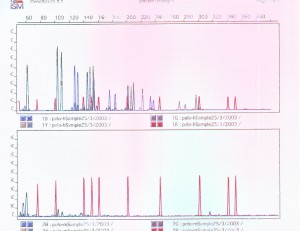
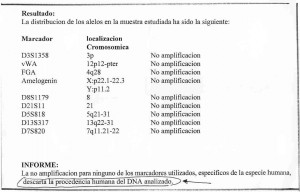
Not surprisingly the results are as anticlimactic as the tooth DNA results. The hair samples also state that the extracted DNA is not of human origin. The skull itself has not been submitted to scientific study. Virgilio had told me that taking such object outside of the U.S. proves to be a difficult process with U.S. Customs.
So what does the ’10 year Chupacabras Study’ yield in the end?
A strange hypodermic-like tooth and hair evidence whose DNA is not Human, cat or dog’s.
Virgilio has spent the last decade or so working hard in investigating these strange Chupacabras reports. Donating much of his own money and countless hours to his plight, but to only end up with ambiguous evidence. The cryptic fields of science (paranormal/Cryptozoology) are not glamorous ones. There is a lot of hard work, research, disappointment and ridicule that comes with the territory. One must always stay on their toes when presenting evidence to the scientific community or face public humiliation.
I know Virgilio has done his homework in the investigation of the Chupacabras, but with such inconclusive evidence that his 10 year study has produced, one can’t help but to be upset that the results were not so concrete.
In the end, Virgilio (as well as other Chupacabras investigators) can only hope that these results of “unknown animal DNA” could be from an animal unknown to science, but for now he must continue on with his sisyphean plight.
Good luck!
13 comments
